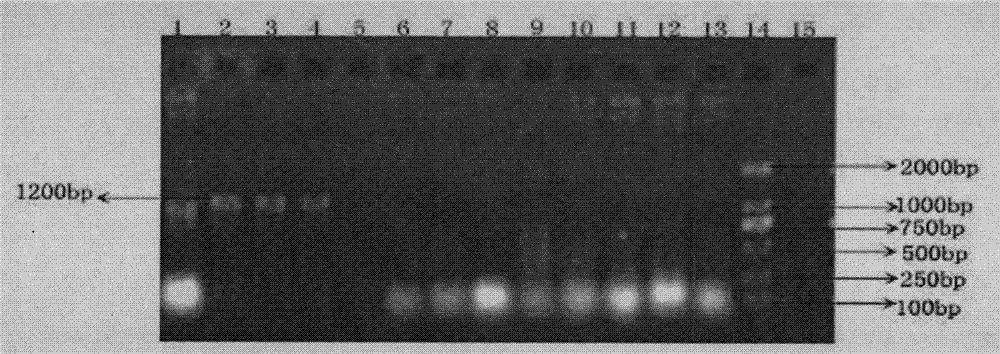Apricot cold-resist gene transformation method
A gene transformation and gene technology, applied in the field of biotechnology and modern agriculture, can solve the problems that the transgene is limited by the genetic transformation system, and it is difficult to genetically transform and screen multi-genotype receptors, so as to enrich new germplasm resources and improve The effect of cold resistance properties
- Summary
- Abstract
- Description
- Claims
- Application Information
AI Technical Summary
Problems solved by technology
Method used
Image
Examples
Embodiment 1
[0037] Molecular detection of transgenic apricot tissue culture seedlings:
[0038] Take about 0.3 g of young apricot leaf tissue, extract plant DNA by CTAB method, dissolve in TE solution, and store at -20°C. The extracted transgenic apricot leaf DNA was used as a template, the plasmid DNA was used as a positive control, and the untransformed apricot leaf DNA was used as a negative control for PCR amplification detection.
[0039] The target gene primer sequence is:
[0040] Primer 1: 5′-ATGTCGGATGATGAAAGGGAGGAGAAGGA-3′,
[0041] Primer 2: 5'-TAGGGAAGGGAGGTCAATCTTGAGGTGT-3'.
[0042] The reaction system is: 10×Taq Buffer (Mg2+) 2.0ul, dNTP1.0ul, primer 0.8ul, template 1.0ul, TaqDNA polymerase 0.3ul, ddH 2 O15.1ul amplification program is: pre-denaturation at 94°C, 4min; denaturation at 94°C, 45s; annealing at 55°C, 45s; extension at 72°C, 1min, final extension at 72°C, 5min; 1.0% agar for 35 cycles of amplification products Glucose gel electrophoresis, EB staining observa...
Embodiment 2
[0045] Effect of different exogenous DNA concentrations on gene transformation rate:
[0046] PCR molecular detection was carried out on the 7th, 30th, and 60th days after the transformation, respectively, and 10 fruits were randomly selected each time. The DNA of the whole young fruit was detected and extracted on the 7th day, and the DNA of the seeds was extracted after the 30th day. After the detection, the positive rate was counted, and the results are shown in Table 2. The introduction effect of the pollen mixed with the exogenous gene was significantly higher than that of the bombarded pollen by the gene gun.
[0047] Table 2 The impact of different processing methods on the gene conversion rate
[0048]
[0049] Depend on Figure 4 It can be seen that when the concentration of imported DNA is 500 μg / mL, the positive rate of fruit setting is the highest, reaching 75% at the 7th day, and 22.5% after 60 days. The DNA concentration had the least effect on the growth of...
Embodiment 3
[0051] The influence of different ways to deal with the stigma on the gene conversion rate:
[0052] After the pollen was pollinated in different ways, the stigma was subjected to three treatments of excising 0, 1 / 2, and completely excision, and the AmEBP1 plasmid DNA was introduced at a concentration of 500 μg / mL. For the detection, 10 fruits were randomly selected each time, the DNA of the whole young fruit was detected and extracted on the 7th day, and the DNA of the seeds was extracted after the 30th day, and the positive rate was counted after PCR detection. The results are shown in Table 3.
[0053] It can be seen from Table 4 that when the concentration of introduced DNA is 500 μg / mL, the positive rate of fruit setting after cutting off 1 / 2 style is the highest, reaching 75% at 7 days, and 30% after 60 days, indicating that cutting 1 / 2 style, transgenic The highest success rate. After cutting off 1 / 2 style, the distance of pollen entering the embryo sac is shortened, a...
PUM
 Login to View More
Login to View More Abstract
Description
Claims
Application Information
 Login to View More
Login to View More - R&D Engineer
- R&D Manager
- IP Professional
- Industry Leading Data Capabilities
- Powerful AI technology
- Patent DNA Extraction
Browse by: Latest US Patents, China's latest patents, Technical Efficacy Thesaurus, Application Domain, Technology Topic, Popular Technical Reports.
© 2024 PatSnap. All rights reserved.Legal|Privacy policy|Modern Slavery Act Transparency Statement|Sitemap|About US| Contact US: help@patsnap.com










